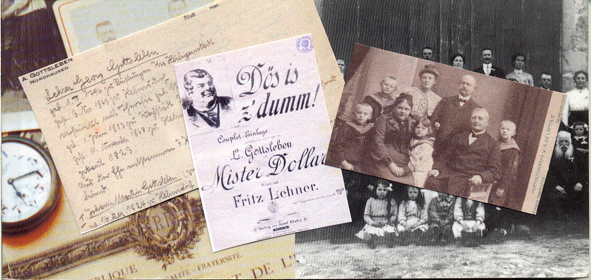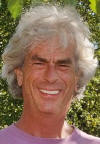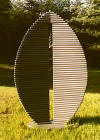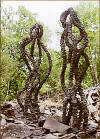|
                                       sleben_familien_linien.htm_cmp_axis010_hbtn.gif)         
|

Tom
Gottsleben
1950-2019
Sculptor
and painter, Massachusetts

Tom Gottsleben


Tom
Gottsleben
It
seemed fitting that the artist Tom Gottsleben lived and worked in
what had once been an abandoned Saugerties stone quarry. Gottsleben,
who had been a painter before coming to the property in 1982, discovered
early on that the stone there had the potential to express deep and
timeless ideas. They were ideas he had been exploring since childhood when
he was captivated by the teachings of the late Indian sage Ramana Maharshi.
Over some
three decades, Gottsleben transformed the property into a garden
for his bluestone and crystal sculpture and a five-level spiral house that
was built almost entirely from stone quarried on site. He designed the
home with his wife, Patty Livingston, using principles of sacred geometry,
with input from engineers only at the very end. But more than the discrete
elements that Gottsleben created — a unique home, the visionary and
joyful sculpture dotting the property, and the serpentine stone walls,
gardens, and trails that tie it together — he took what had been a ravaged
35-acre landscape and returned it to unity with the Catskill terrain that
was its origin. Gottsleben died there unexpectedly on Tuesday
evening, January 15.
The
spiral figures in much of Gottsleben’s work. From our galaxy to our
DNA, the spiral is the form of growth and the metaphor for the spiritual
path, Gottsleben explained in a 2006 interview with Spirituality
& Health magazine. “All of your experience brings you back to a
greater awareness of who you are; that’s the spiral,” the artist said.
"You start at the center and come back to it through this wonderful
circumambulation of experience."
Gottsleben
liked to point out that the stone and crystal he worked with are actually
the same material: silica. Stone is hard, dense, and opaque, while crystal
is clear, light and transparent. The artist believed that the combination
of the two served as a metaphor for the oneness that we humans often
interpret as a duality of opposites. This exploration of unity informed
both Gottsleben’s work and his life: a desire to make art that
evokes essential truths. The result was art that is both intellectually
complex and yet beautiful, mathematically precise and also poetic. His
work — including the 25-foot wide, 12-foot high bluestone and colored
glass rainbow of seven arches — appealed equally to children of all ages.
His work
was a reflection of a quirky, unorthodox, and inclusive personality. He
believed in working with what the universe provided — the stone on their
property, the many local artisans who contributed to the Spiral House —
rather than striving for what one didn’t have. He lived in a state of
wonder and awe at the world around him, curious about and generous to
everyone he met, mentoring many in their commitment to a spiritual path. A
vegan for nearly 30 years, Gottsleben had a respect and compassion
for all lifeforms, from the tiniest bugs and critters to a work crew who
were more like family.
Born in
Milwaukee, Wisconsin on November 11, 1950 to the late Gloria Louise
Blaisdell Gottsleben and the late Colonel
Alvin Gottsleben, the
artist was an Air Force brat who came of age in the 1960s. He would say he
was educated at the San Francisco Art Institute and an Indian ashram. An
early devotee in the 1970s of Guru Maharaj Ji, now known as Prem Rawat, he
showed a talent for business management at the teacher’s Divine Light
Mission network and later in the corporate world.
After
meeting his wife in 1982, Gottsleben began commuting between his
business consultancy work in New York City and the ranch house on the
Saugerties property. City life soon gave way to country life just as his
painting gave way to sculpture. Gottsleben found a story in every
stone he collected on the daily walks he and Patty took with their
Airedale, Rafferty. After the sudden death of this beloved dog in 1988,
the artist built a stone bench as a memorial. The bench led to undulating
stone walls and a stone fountain that, in turn, launched him into stone
sculpture.
Gottsleben’s
sculpture has been the subject of solo exhibitions at the Neuberger Museum
of Art in Purchase, Art Omi International in Ghent, and The Museum at
Bethel Woods in Bethel; and in group shows at the New York Botanical
Garden in the Bronx, and the annual Contemporary Sculpture at Chesterwood
in Stockbridge, MA. His work is included in numerous private collections
and is represented by the Elena Zang Gallery in Woodstock, where he
regularly exhibited.
Just
prior to his death, Gottsleben and his wife had completed a book
titled The Spiral House: Revealing the Sacred in Everyday Life that
will be released by the art book publisher Glitterati Editions in late
March. He had also recently finished Rainbow Portal, a monumental
work of 12 continuous rising and falling archways of stone and colored
crystal glass that form a circle with a large crystal at its center. By
day, the sculpture sparkles in the sunshine, casting colorful reflections
and projections. At night,
illuminated by artificial light, it is otherworldly.
On Saturday
evening as Patty was photographing Rainbow Portal in the snowfall
with her mobile phone, the device suddenly began playing Louis Armstrong
singing "It’s A Wonderful World," a perspective that was central to
Gottsleben’s life. Coincidence? Or a sign penetrating the veil that
separates life and death? Those who knew him well believe Tom would have
said, as he did about many revelations involving the Spiral House, "I’m
not making this up."
Friends
recall that when Gottsleben was diagnosed with cancer nine years
ago, a disease from which he was later cured, he told friends in a
meditation circle, "I am not Tom Gottsleben. I am not this body. Be
glad for me." On birthday cards, and there were dozens celebrated at the
Spiral House each year, Tom always signed: "Keep on growing, glowing and
going beyond."
In
addition to his wife, Patricia Livingston, Gottsleben is survived
by a sister, Gloria Gottsleben of Littleton, CO; cousins, nieces
and nephews; and a wide circle of friends and colleagues that make up the
Spiral House community. A memorial for family and close friends will be
scheduled at the property in the spring. Gottsleben’s art can be
viewed locally at the Elena Zang Gallery in Woodstock and on his website,
tomgottsleben.com.
In lieu of flowers, donations can be made to the Catskill Animal Sanctuary
in Saugerties People for the Ethical Treatment of Animals, and the Ulster
County SPCA.
Quelle: Andrea
Barrist Stern and Ronnie Shushan: Obituaries, Tom Gottsleben,
January 24, 2019 (Hudsonvalleyone.com/obituaries;
Februar 2019)

Bilder
Tom Gottsleben
|

Patty and Tom |

|

Syzygy
2001 ©
H 80" | W 47 1/2" | D 14"
Bluestone, Stainless Steel
|

Shadow Dancer 1995 ©
Group Bluestone & Stainless steel
|


The Spiral House
|
The
Gottsleben Home, an architectural wonder unto itself, called for numerous
railings and balconies to complete its exterior. The theme of the house is
spirals, and Infusion was commissioned to create railings that not only
reflected this theme, but also each twist created a complete line that
mimicked the outline of the nearby Catskill Mountain range.

"The
design of the Spiral House is based on the universal precepts of
sacred geometry and sacred architecture. In this light, a house or
temple (or sculpture, for that matter) should architecturally and
physically express both a cosmology and a physiology: it should be a
reflection of the wisdom "'as above - so below", as well as embody
the 'macrocosm / microcosm' insight. It should be a place where a
sense of the sacred can be tangibly experienced; a meeting place of
heaven and earth where the practical and the spiritual are balanced
and integrated with the environment.
The spiral is a universal form and pattern found in all cultures,
since the very beginning of mankind's markings. It is the shape of
both our galaxy as well as our DNA, and therefore - is an excellent
symbol of the macrocosm/microcosm insight. The spiral is a sign of
movement and growth, as it describes a path and connection from the
center to its periphery, in a fractal - or self similar way. Some
spirals, like the spiral of the nautilus shell, literally embody the
ideal or Golden Proportioning system (a.k.a. The Fibonacci
Sequence), which has been used in art and architecture since
antiquity to emulate nature's patterns of proportion, harmony, and
beauty. When designing our new home, the spiral form of the nautilus
shell best expressed a sense of organic growth and harmony with
nature - in a way that would be functional, yet also stimulate and
inspire those who would experience it.
The spiral house was designed and built by my wife Patty and myself,
along with a lot of help from our friends. It is a 5 story spiral
structure that 'turns' 2 1/4 times around it's axis; the central
column of a 32 ft. stainless steel and glass spiral staircase.
Constructed of concrete, steel, bluestone, wood, glass, and copper,
it was completed in 2001."
|
|

Stand: März
2019
Klaus Gottsleben
gottsleben-genealogie.de/com

|
![]()
![]()